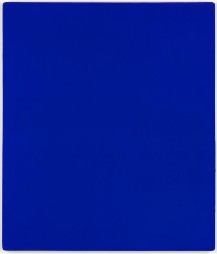
Upon entering the exhibition space one is immediately struck by the uniqueness of what is being shown. The fabled trademarked IKB (International Klein Blue) is present in abundance.
I am told by the attendant that, of the Monochromes 1955 -1961 – rectangular tablets of varying size, support thickness and surface texture, in clear Perspex box frames, Monochrome Green, Untitled [ M35 ] 1957 one was once owned by Warhol, who Klein met in 1961; particularly striking in this group, and one of its largest works, was Monochrome White, Untitled [M 70] 1957, made an ultra gorgeous art object by the sumptuous, minimal gilt frame that decorates the clear box it inhabits.

There are four of Klein’s smaller Fire Paintings, 1960-61, one of which belonged to Lucio Fontana. Examples of larger scale Fire Colour paintings: (FC 28) – the composition of scorch and singe marks, mixed with gestural splashes of IKB, on specially treated cardboard on panel, is a delight.
At the centre of the exhibition are Klein’s sponge relief paintings, sponge sculptures and Anthropometry paintings. The very cleverness of the sponge paintings and sculptures inspire awe; Blue Sponge Relief (Little Night Music) 1960, an imposing 1.5 m x 1 m in size, is typical and incorporates pebbles and stones within its lunar surface; the sculptures project odd surrealist presences, hanging in space, combining the very natural with vividly coloured, sometimes lurid (mustard yellow, dusty pink) pigmented resin. The Anthropometry (performance art) paintings, in essence body mono-prints, were created at collaborative events in 1960; there is adjacent black and white footage of the ever dapper Klein , female models wearing only IKB and a small orchestra performing before an audience at such an event. The best of these is Untitled Anthropometry [ ANT 90 ] which features, poignantly, above the blue torso and between the outstretched arms, the red lipstick traces of a kiss from another time and world.
Collateral interest is provided by photographs of Klein as judo player, Klein throwing himself into space (in fact, photomontage) and footage of his 1961 Monochrome and Fire exhibition.
The final room is dedicated to, perhaps a dozen, maybe more, of Klein’s Blue Monochrome paintings, with their characteristic rounded corners, serving to reinforce the feeling that one has had a glimpse into the mind of one of modern art’s greatest original thinkers.
This is not a large exhibition and it does not purport to be anywhere near comprehensive. It does not disappoint and certainly whets the appetite for more. The monogolds, portrait reliefs, Blue Rain – uphold Klein’s reputation as one of modern art’s most enigmatic players. There is no doubt that Klein’s work belongs in the vast white spaces endemic in modern art appreciation and his place in its pantheon is just and deserved.
Guy Barkley-Smith
Guy Barkley-Smith is a second year student at Plymouth College of Art and one of the editors of SUB magazine.
Volume 31 No 4 March / April 2017 p 32

